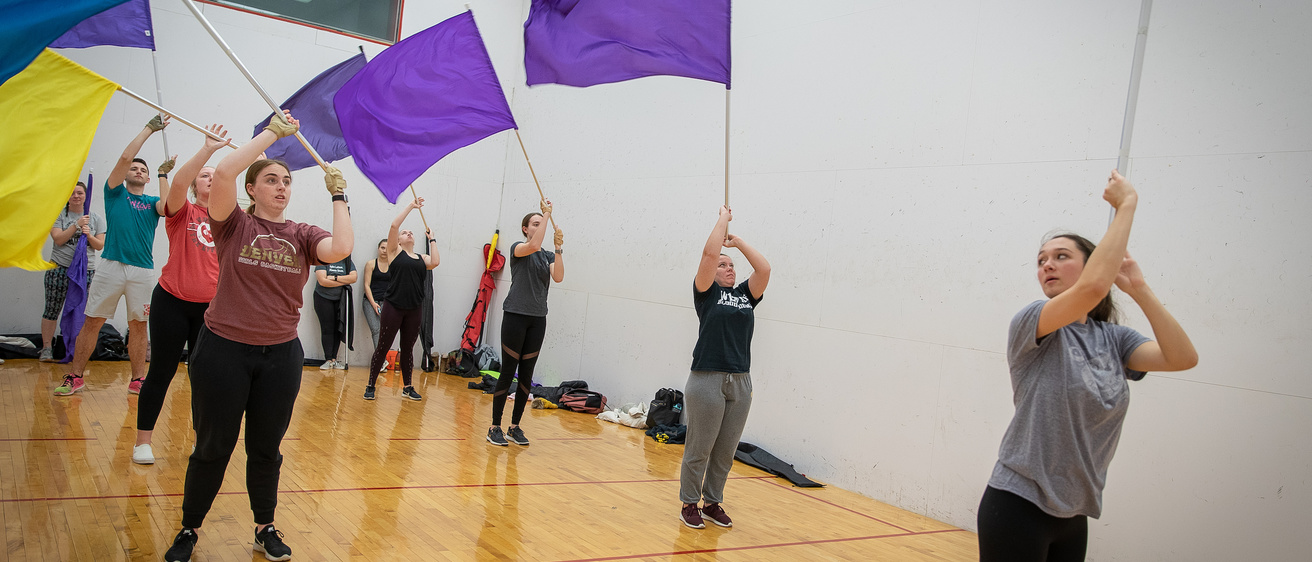What is color guard?
The Color Guard for the University of Iowa is a new organization on the Iowa campus. In color guard, a member utilizes dance and tools such as the flag, rifle and saber to perform. It is a great way to stay active and to make new friends.
Meet Joslyn and Haley
Joslyn Hagener, the President of the Color Guard, is currently a senior at the University of Iowa. She is double majoring in Art and Art Education and she is minoring in Dance. Before college, Hagener was the team captain for her high school’s color guard.
Haley Burton, the Vice President, is currently a Junior at the University of Iowa. She is double majoring in History and Secondary Education and earning a certificate in All Social Studies. Burton also did color guard in high school and is excited to start using her leadership skills in the Color Guard at Iowa.
The beginning
In her second year, Hagener transferred to the University of Iowa from the University of Northern Iowa. She found that the hardest part of the transition was no longer having a color guard to perform with. She teased the idea of starting the Color Guard club herself early on but began thinking critically about it when she was enrolled in an Art Ambassador course. The course required her to create something with a positive impact for the arts department or the University of Iowa. This motivated her to start the process of creating the Color Guard for the University of Iowa and shortly after she messaged Burton, who she had met and discussed color guard with the year before, and asked her if she wanted to help her start a club.
The process
Having the plan to start a new club at the University of Iowa is one thing, but where to start is an entirely new challenge. Luckily for Hagener and Burton, Hagener remembers, “I had remembered seeing a PowerPoint that mentioned creating your own organization during my transfer orientation so I looked up the website and started following the steps.” The website, leadandengage.uiowa.edu lists nine steps to getting an organization approved, and then you’re off to training at the new organization orientation. The nine steps include filling out paperwork, writing a constitution and meetings. There are also requirements to meet before beginning this process; notably, five students must join before you get started and there are limitations to starting organizations similar to established organizations.
Among all of these requirements, Hagener and Burton both noted the paperwork to be the biggest challenge. Burton explains, “Having to create all of the paperwork and stuff going into just a building a framework for an organization as a full-time student was a lot of work.” Overall, the process was extensive in both work put into it, and the time it took. Hagener says, “Getting this organization took a lot more time than I thought.”
“Getting this organization took a lot more time than I thought.”
Where to get help
While the process may have been daunting, the two found help in numerous ways. For starters, Hagener referred to other organizations she was already part of for help making the constitution and other documents. She spoke to another student who started her own club. Some of the best help Hagener found was in Burton. “I knew I needed to find someone just as enthusiastic about color guard as me to help me get the process really going,” Hagener states. Faculty at the University of Iowa was also available to help them.
Challenges as a new club
Now established as an official club at the University of Iowa, the Color Guard is facing different challenges. When asked, each of the women focused on a different challenge. Hagener says, “Our biggest struggle is finding space to practice. Since color guard needs high ceiling space and a good floor to drop on, our options are limited and usually already booked up.” Burton believes, “Expenses seem to be the biggest obstacle at this time because we cannot have a real practice unless everyone has equipment and equipment costs money.”
Advice
Looking back on their experiences, Hagener and Burton have advice for fellow students looking to start their own organization. “My advice would be to talk to other organizations to meet with people in person if you have questions. I found that meeting with people in person is much easier than waiting for an email response,” Hagener shares. Burton adds saying, “Find someone who shares your passion for the organization because having a partner through it all has really made things go so much smoother than if we were alone.”
“Find someone who shares your passion for the organization because having a partner through it all has really made things go so much smoother than if we were alone.”
The future
Amidst all of the complications, both Hagener and Burton have big plans for the future of the Color Guard. A goal for this year’s season is to perform competitively and at Iowa basketball games. In another aspect, making their own silks is something they hope to do some time. In the future, they hope to see the color guard merge with the University of Iowa Marching Band. “Once we become more established, we may have the opportunity and privilege to perform a song or more on the Kinnick Field,” Hagener shares. To make this happen though, they need to grow as a group, specifically in numbers. Burton says, “Anyone is welcome to join! It’s a really cool sport and full of amazing and creative people.”
Want to know more / get involved?
You can follow the University of Iowa Color Guard on instagram @uiowacolorguard.
